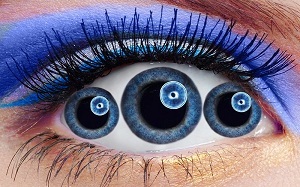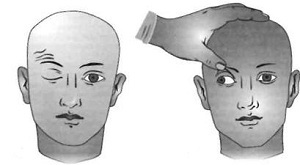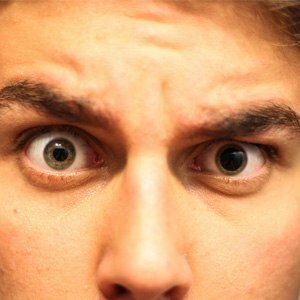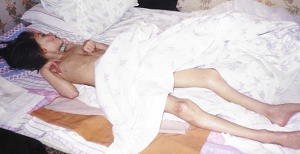 If there is a negative effect on the upper region of the orbit slit, which connects the middle cranial fovea with the orbit, there may be a syndrome of the superior glabellar fissure. As a result of this process, the III, IV, VI nerves of the skull, the first branch of the V nerve, are affected.
If there is a negative effect on the upper region of the orbit slit, which connects the middle cranial fovea with the orbit, there may be a syndrome of the superior glabellar fissure. As a result of this process, the III, IV, VI nerves of the skull, the first branch of the V nerve, are affected.
Complete ophthalmoplegia and anesthesia of various parts of the eye - cornea, upper eyelid, homolateral half of the frontal part.
Causes of
Syndrome The onset of the syndrome is caused by a series of nerve lesions around the eye. From the negative impact suffer:
- oculomotor;
- block;
- Diverter;
- of the eye nerves.
Syndrome can occur as a result of mechanical damage to the eye, and also become a consequence of various diseases in the human body:
- A common cause of the syndrome is the emergence of tumors in the brain of .With their close location to the eye,
 they can cause nerve damage.
they can cause nerve damage. - There is a syndrome with arachnoiditis .In this case, it is caused by inflammation of the arachnoid membrane in the brain.
- With meningitis , a complication may occur in the area of the upper glottis.
- If the orbit of the eye has been injured by , damage can lead to the onset of the syndrome.
- Sometimes the syndrome is caused by by ingestion of a foreign body into the eye area of .As a result of this, the nerve endings and the vein in the upper region of the orbit may be squeezed.
Symptoms of the disease
For the syndrome of the upper ophthalmic gaps, the following symptoms are typical:
- When the upper eyelid descends ptosis .The eye gap can completely or partially close.

- As a result of the development of the pathological state of the oculomotor nerves, the appearance of paralysis of the eye muscles can be noted. This condition is called of ophthalmoplegia .A sick person is noted to have no motor activity of the eyeball.
- The skin of the eyelids and cornea becomes less sensitive to at tactile contact.
- After lesion, the pupil can expand( mydriasis ).This state is caused by a decrease in the amount of light, as well as by poisoning with chemicals.
- syndrome widens the veins of the retina , and changes in the arteries also occur.
- As a result of defeat of the trigeminal nerve cornea becomes inflamed. The process is called a neuroparalytic keratitis and proceeds lethargic.
- Occasionally, the appearance of blistering - exophthalmos , is observed in which the eyeball is exposed.
Diagnosis of the syndrome
Diagnosis of the syndrome is difficult due to the similarity of its symptoms to other diseases. The appearance of signs that are noted in the syndrome may be due to the manifestations:
- parasellar and tumors of the middle fossa of the skull, pterygoid, pituitary gland;
- retrobulbar bulk processes;
- carotid artery aneurysms;
- of periostitis;
- osteomyelitis, etc.
 Symptoms are also characteristic of myasthenic disorders, thyroid diseases, temporal arteritis, meningitis, multiple sclerosis, migraine with aura. All diseases can become a source of education for ophthalmoplegia as a result of dysfunction of the nerves of the cranial region.
Symptoms are also characteristic of myasthenic disorders, thyroid diseases, temporal arteritis, meningitis, multiple sclerosis, migraine with aura. All diseases can become a source of education for ophthalmoplegia as a result of dysfunction of the nerves of the cranial region.
Therefore, when you go to a medical facility, the patient needs to undergo a diagnosis. At the first stage, an ophthalmologist is examined. He examines the fields and visual acuity, the condition of the fundus.
After examining the eyes, a neurologist is connected to the work. The doctor interrogates the patient during the course of anamnesis. A detailed examination is also shown.
Among the methods of instrumental diagnostics are:
- CT ( computed tomography) of the brain and Turkish saddle;
- MRI ( magnetic resonance imaging) of the brain and the Turkish saddle.
- also carries out angiography and sonography .
If in diagnosis during an MRI examination a granulomatous inflammation of the outer wall of the cavernous sinus is detected, then the Tolosa-Hunt syndrome is diagnosed.
A biopsy is performed to confirm the result. In the absence of granuloma, a diagnosis is made of "upper globular cavity syndrome".
Methods of therapy and prevention
Treatment of the syndrome is carried out with the help of immunosuppressive therapy. At the researches spent at a choice of therapy for the given disease, the highest efficiency was shown by corticosteroids. 
When diagnosing a syndrome, a patient may be prescribed Prednisolone, as well as a drug with a similar Medrol action. When taking the tablets, a dosage of 1 to 1.5 mg is observed, depending on the weight of the patient's body( multiplying the indicated dosage by the amount of kg).Also, the drug is administered intravenously. Daily dose of 500 to 1000 mg is indicated.
The result after application of steroids is estimated after 3 days. If the diagnosis is correct, the symptoms should disappear. However, the drug contributes to a decrease in signs that also manifest with:
- pachymeningitis;
- chordoma;
- lymphoma;
- aneurysm;
- carcinoma.
Therefore, it is important to correctly diagnose, that treatment was conducted in the direction of its elimination. Also, in the course of symptomatic therapy, analgesics and anticonvulsants are used to reduce pain. The method of common metabolic agents and vitamins is shown to strengthen all body systems.
Preventive measures are applied depending on the disease, which triggered the syndrome of the upper globule. If the syndrome occurs as a result of trauma, then further damage to the eye should be avoided. This can lead to irreversible consequences.
The main rule after the onset of the syndrome is an emergency consultation of an ophthalmologist and a neurologist. They will help in time to diagnose the disease and prevent complications by prescribing therapy.



